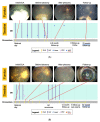Tylectomy Safety in Salvage of Eyes with Retinoblastoma
- PMID: 34831013
- PMCID: PMC8616183
- DOI: 10.3390/cancers13225862
Tylectomy Safety in Salvage of Eyes with Retinoblastoma
Abstract
Intraocular surgery is tabooed in retinoblastoma management, due to the concern of lethal extraocular spread. We reviewed the outcomes of consecutive children with intraocular retinoblastoma diagnosed at 29 Chinese centers between 2012-2014. We compared the outcomes of three categories of treatment: eye salvage including tylectomy (Group I), eye salvage without tylectomy (Group II), and primary enucleation (Group III). A total of 960 patients (1243 eyes) were diagnosed: 256 in Group I, 370 in Group II, and 293 in Group III; 41 patients abandoned treatment upfront. The estimated 5-year overall survivals (OS) were, for Group I, 94%, for Group II 89%, and for Group III 95%. The estimated 5-year disease-specific survivals (DSS) were, for Group I, 96%, for Group II 90%, and for Group III 95%. Patients in Group I had a significantly higher 5-year DSS than patients in Group II (p = 0.003) and not significantly different than patients in Group III (p = 0.367). Overall survival was not compromised by the inclusion of tylectomy in eye salvage therapy compared to eye salvage without tylectomy or primary enucleation. Disease-specific survival was better when tylectomy was included in eye salvage treatments. Tylectomy as part of multimodal treatment may contribute to the care of retinoblastoma patients with chemotherapy-resistant tumor, eyes with concomitant ocular complications, or at the risk of treatment abandonment.
Keywords: endoresection; enucleation; pars plana vitrectomy; resection; retinoblastoma; safety; surgery; survival; tylectomy.
Conflict of interest statement
The authors declare no conflict of interest.
Figures



Similar articles
-
Impact of Systemic Chemotherapy and Delayed Enucleation on Survival of Children with Advanced Intraocular Retinoblastoma.Ophthalmol Retina. 2020 Jun;4(6):630-639. doi: 10.1016/j.oret.2020.02.015. Epub 2020 Mar 4. Ophthalmol Retina. 2020. PMID: 32387053
-
Effectiveness of intravitreal chemotherapy-assisted endoresection in monocular patients with group D retinoblastoma.BMC Cancer. 2020 Aug 26;20(1):808. doi: 10.1186/s12885-020-07314-1. BMC Cancer. 2020. PMID: 32847550 Free PMC article.
-
Delayed Enucleation With Neoadjuvant Chemotherapy in Advanced Intraocular Unilateral Retinoblastoma: AHOPCA II, a Prospective, Multi-Institutional Protocol in Central America.J Clin Oncol. 2019 Nov 1;37(31):2875-2882. doi: 10.1200/JCO.18.00141. Epub 2019 Sep 19. J Clin Oncol. 2019. PMID: 31536438 Free PMC article.
-
Aqueous seeding in intraocular retinoblastoma: A review.Clin Exp Ophthalmol. 2021 Aug;49(6):606-614. doi: 10.1111/ceo.13964. Epub 2021 Jul 9. Clin Exp Ophthalmol. 2021. PMID: 34185374 Review.
-
Current treatment of retinoblastoma.Curr Opin Ophthalmol. 2002 Oct;13(5):331-6. doi: 10.1097/00055735-200210000-00007. Curr Opin Ophthalmol. 2002. PMID: 12218465 Review.
Cited by
-
Comparative study on genomic and epigenomic profiles of retinoblastoma or tuberous sclerosis complex via nanopore sequencing and a joint screening framework.Cancer Gene Ther. 2024 Mar;31(3):439-453. doi: 10.1038/s41417-023-00714-y. Epub 2023 Dec 25. Cancer Gene Ther. 2024. PMID: 38146007
-
Retinoblastoma - A comprehensive review, update and recent advances.Indian J Ophthalmol. 2024 Jun 1;72(6):778-788. doi: 10.4103/IJO.IJO_2414_23. Epub 2024 May 24. Indian J Ophthalmol. 2024. PMID: 38804799 Free PMC article. Review.
-
Optic Nerve Invasion in Retinoblastoma: Impact of Eye Salvage and Adjuvant Chemotherapy.Invest Ophthalmol Vis Sci. 2025 Jun 2;66(6):65. doi: 10.1167/iovs.66.6.65. Invest Ophthalmol Vis Sci. 2025. PMID: 40548635 Free PMC article.
-
Update on Retinoblastoma Therapies.Medicina (Kaunas). 2025 Jul 4;61(7):1219. doi: 10.3390/medicina61071219. Medicina (Kaunas). 2025. PMID: 40731848 Free PMC article. Review.
-
Adjuvant Chemotherapy Improves Survival for Children With Massive Choroidal Invasion of Retinoblastoma.Invest Ophthalmol Vis Sci. 2023 Aug 1;64(11):27. doi: 10.1167/iovs.64.11.27. Invest Ophthalmol Vis Sci. 2023. PMID: 37603354 Free PMC article.
References
-
- Francis J.H., Abramson D.H., Ji X., Shields C.L., Teixeira L.F., Schefler A.C., Cassoux N., Hadjistilianou D., Berry J.L., Frenkel S., et al. Risk of Extraocular Extension in Eyes With Retinoblastoma Receiving Intravitreous Chemotherapy. JAMA Ophthalmol. 2017;135:1426–1429. doi: 10.1001/jamaophthalmol.2017.4600. - DOI - PMC - PubMed
LinkOut - more resources
Full Text Sources
Miscellaneous

